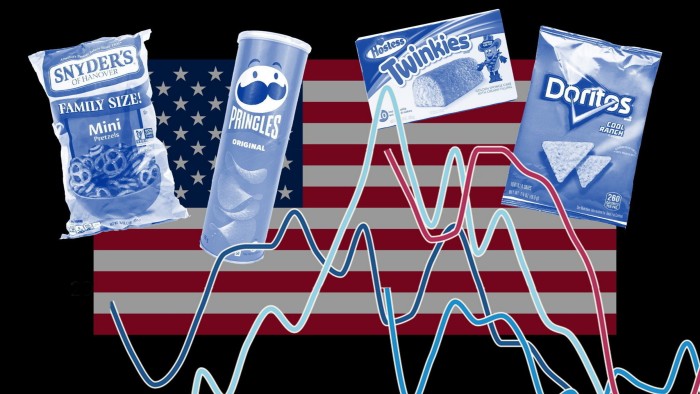Big Food’s bet on America’s appetite for snacks is turning sour.
Cookies, chocolate bars and potato chips are among the snacks being left on the shelves as US consumers rein in spending, according to grocery scanner tracker Circana.
Sweet snacks are bearing the brunt of the pain: unit sales of sweet treats have declined by 6.1 per cent and salty snacks by 1.2 per cent in the US over the past year, according to checkout data collected by NielsenIQ.
The declines are the latest problem facing packaged food groups — such as PepsiCo, General Mills, JM Smucker and Campbell’s — which are also threatened by new constraints on food subsidies under US President Donald Trump’s tax and spending bill.
Americans are reducing snack purchases after years of heavy-handed price rises by food manufacturers. Some lower-income consumers have responded by cooking more from scratch or cutting back on small luxuries, analysts say.
But some observers are wondering whether consumers’ use of GLP-1 weight-loss drugs, such as Ozempic, or concerns about the health risks of eating ultra-processed foods will permanently reduce snacking.
The use of GLP-1 medications has already caused US grocery volume losses of between 1.2 per cent and 2.9 per cent, estimates Big Chalk Analytics, a consumer goods industry consultancy.
Nik Modi, a consumer goods analyst at RBC Capital Markets, said “the big debate” swirling around the industry was whether the current struggles were a passing setback or the start of a longer-lasting behavioural shift.
“The prevailing logic . . . would suggest that it’s something more structural in nature — and the whole advent of GLP-1s adds to that spectre,” he said.
However, Modi added that he believed “a big chunk” of the sales decline was down to “the economy”.
While sales are struggling across the packaged food sector, the decline in snack sales has been particularly severe. The trend is upsetting wagers made in previous years, when food companies gorged themselves on multibillion-dollar acquisitions of snacking brands to boost overall growth.
The rationale was that “snacks were going to save all the food companies”, said Nicholas Fereday, a food analyst at Rabobank. “But that seems to have stopped working.”
In 2018 Campbell’s — then known as Campbell Soup — bought pretzel maker Snyder’s-Lance for $6.1bn. Then-chief executive Denise Morrison hailed a “transformative acquisition” that would increase sales from the “faster-growing snacks category”. But sales of snacks dropped by 5 per cent year on year in Campbell’s latest quarter.
A spokeswoman for the company, which also wrote down the value of its Snyder’s of Hanover pretzel brand by $150mn, maintained that the Snyder’s-Lance deal transformed Campbell’s into a more diversified, growth-oriented company. Many of Campbell’s snacks brands held the number one or two position in their categories, she added.
JM Smucker, famous for its jellies and jams, acquired Twinkies baker Hostess Brands for $5.6bn in 2023. In June, the company reported a 14 per cent slide in underlying quarterly revenues at its sweet baked snacks division, which includes Hostess.
Chief executive Mark Smucker told analysts that consumers would keep snacking but some wanted smaller portion sizes or snacks with less sugar.
Other food giants jumped on the snacking trend, too. In 2022, Mondelez paid $2.9bn for Clif Bar, a maker of nut butter bars, and Hershey bought Dot’s Pretzels in 2021 for $894mn. The chocolate maker followed that with a $750mn deal for organic snacks group LesserEvil in April this year.
Kellogg spun off its breakfast cereal business in 2023 and renamed itself Kellanova with a grand vision of becoming a “global snacking powerhouse”. Mars, undeterred by the prevailing slowdown in snack sales, is seeking to close a $35.9bn takeover of Kellanova, whose products include Pringles.
Poul Weihrauch, Mars chief executive, told the Financial Times in an interview last August that “there’s a growing trend of snacking around the world, which will continue to exist”. He also noted the rise of more wholesome snacks in Kellanova’s portfolio.
Some companies are introducing smaller pack sizes to tempt consumers who are feeling the squeeze. Campbell’s is selling a 2.5-oz pack of Goldfish crackers for less than $2, while Mondelez chocolates range from bite-sized items to family sizes.
Others are introducing new flavours to try and revive sales, including General Mills, which is adding spicy varieties to products including Chex party mix and Bugles corn chips.
Sally Lyons Wyatt, executive vice-president at Circana, said that almost half of US consumers still snacked three or more times a day, a statistic that suggests they are snacking differently rather than stopping altogether.
Sales of snacks laden with salt and sugar are on the wane but healthier alternatives, including nutrition bars and yoghurt, are growing, according to market research firm Spins.
Peter Galbo, US consumer staples analyst at Bank of America, said that with budgets under pressure consumers were tending to either spend more for a snack they perceive as healthier or trade down to a value brand.
He pointed to triple-digit sales growth of Boulder Canyon avocado oil crisps, made by Utz Brands, and to PepsiCo’s value tortilla chip brand, which Galbo said was also growing “at a good clip”.
But snack makers are also facing fiercer competition from fast-food restaurants, which have started offering $5 meal deals.
“When you can go to McDonald’s and get a 1,300-calorie meal box for the same amount, you are going to take that over a bag of chips and a soda,” Galbo said.
Read the full article here




